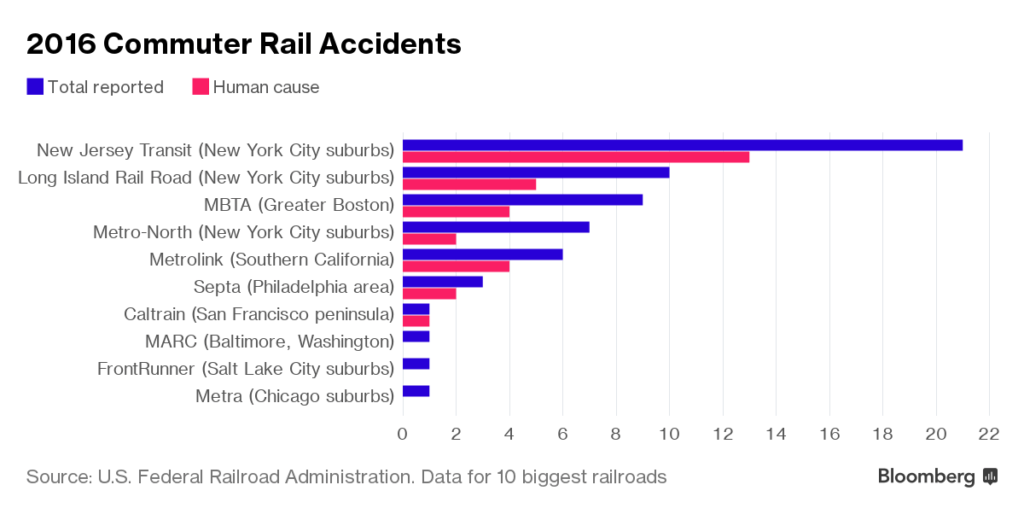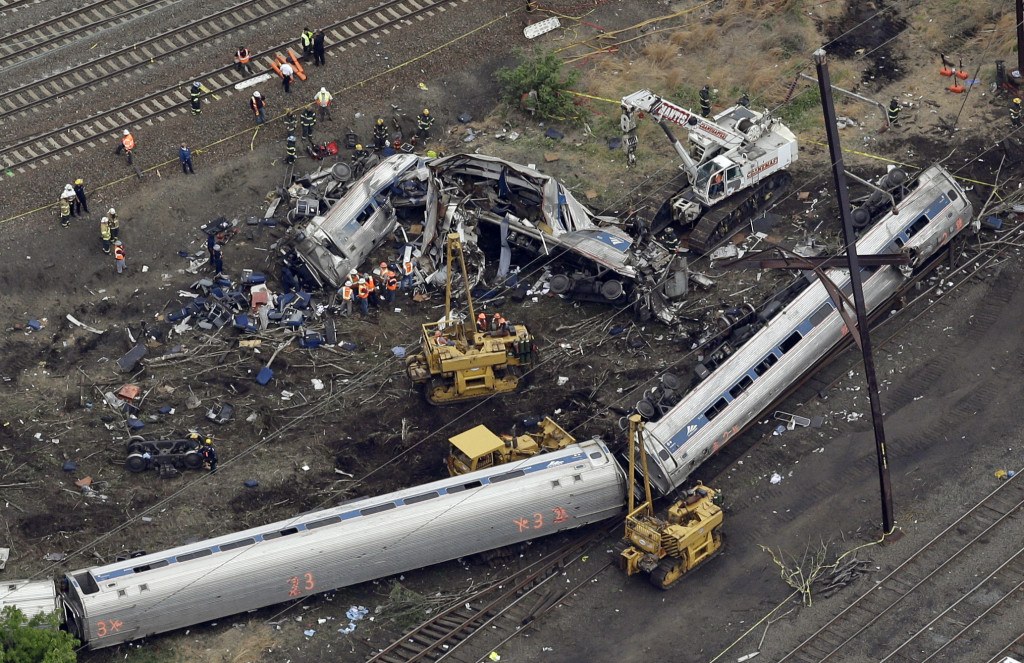New Jersey Transit, under state and federal inquiry for violating safety rules and operating protocols, logged the most accidents last year among the 10 biggest U.S. commuter railroads, federal records show.
The 21 accidents disclosed online by the Federal Railroad Administration on March 1 were more than double those involving the Long Island Rail Road, the nation’s largest passenger-train service. New Jersey Transit also had the most mechanical breakdowns in 2015, the most recent data available.

The agency, the nation’s third-largest public-transportation system, has struggled to turn around operations as ridership increases, but public funding does not. After years of diverting capital-project money to cover day-to-day costs, New Jersey Transit is strapped. Its woes have forced rail commuters to pay higher fares while suffering increased delays and crowding.
“The agency is in a state of crisis,” said Senator Bob Gordon, a Democrat from Fair Lawn who is co-leading a legislative inquiry of New Jersey Transit. “I don’t have high hopes for any short-term relief.”
New Jersey Transit, with 79 million rail passengers a year, had its first fatal train accident in 20 years in 2016. The wreck in Hoboken, across the Hudson River from Manhattan, killed a woman standing on a platform and injured more than 100 passengers.
Train Control
The agency faces a December 2018 federal deadline to install positive train control, technology that can override human error. New Jersey Transit was among the railroads granted a waiver from the December 2015 installation deadline after complaints to Congress that it was an unfunded mandate that couldn’t be completed on time.
Federal investigators are examining whether the technology could have prevented the Hoboken crash, when a train traveling twice the speed limit slammed into the station. That run had one car fewer than normal, and riders were so crammed in the aisles that a conductor couldn’t collect fares, according to a preliminary report by the National Transportation Safety Board.
New Jersey Transit’s total accidents in 2016 were its fewest since at least 2007, records show, and less than half the 2010 peak. Human behavior had a role in 62 percent of the accidents, also a 10-year low.
“That is a testament to this agency’s re-dedication and commitment to keeping safety the No. 1 priority,” spokeswoman Nancy Snyder said in an email. The agency has more workers in two yards to reduce incidents involving track switches, and installed technology in a third yard to help crews identify switch positions, Snyder said. Safety personnel educate staff daily and make inspections bi-weekly.
Rail Woes
Still, no other railroad had as many accidents last year, and it is the national leader over 10 years, with 314 mishaps. Human behavior had a role in 165 of those incidents while the other nine railroads combined logged 169 instances.
Though New Jersey Transit says it will meet the train-control deadline, the system’s cost has soared to $320 million, or 42 percent higher than planned. As of Sept. 30, the agency had yet to outfit the technology on any of its 440 locomotives or 11 track segments, and none of its 1,000 employees have been instructed in its use, federal data show.
Other New York-area railroads with 2018 due dates are further along. The Long Island Rail Road and Metro-North have started staff training. PATH, run by the Port Authority of New York and New Jersey, is almost done with locomotives and education.
Christopher Hart, chairman of the National Transportation Safety Board, said in May that the technology in 2015 would have prevented eight deaths and hundreds of injuries when Amtrak Train 188, operated by a distracted engineer going twice the speed limit, derailed in Philadelphia.
Amtrak activated that track section six months later and has completed about 63 percent of its national crash-prevention project, records show.
Sleep Apnea
In the Hoboken crash, the engineer’s attorney has said his client had undiagnosed sleep apnea, a disorder that can cause tiredness. In an accident investigation, federal regulators classify falling asleep as a “human factor,” a category that also includes speeding, drug or alcohol impairment and distraction.
Crew fatigue has a role in about 25 percent of accidents attributed to human factors, according to Federal Railroad Administration research. Last year, amid the administration’s audit of New Jersey Transit’s declining safety, investigators found widespread questionable entries in daily duty logs, designed to document workers’ sufficient rest between assignments.
The matter was referred to regulators for possible fines. New Jersey Transit filed disciplinary charges against 36 employees, even as it said most of the lapses were record-keeping errors. The railroad ordered apnea screening for all its engineers, and a dozen who tested positive were barred from service pending treatment.
The railroad administration’s review, ongoing since June, also documented dozens of violations, including personal phone use while on duty and a lack of on-board emergency tools.
Cash Crunch
Funding cuts are at the root of New Jersey Transit’s troubles, Steve Santoro, the agency’s director, told lawmakers in November during hearings into the agency’s safety and finances. At that hearing, Santoro disclosed that the agency’s safety office was understaffed, and pledged to fill vacancies.
Governor Chris Christie’s spending plan for the fiscal year that starts July 1 proposes flat operating support, $141 million, for New Jersey Transit. During his Feb. 28 budget address, he also proposed a $400 million supplemental appropriation for transportation this year. Under a bill moving through the legislature, New Jersey Transit would get $140 million of that for safety and technology projects.
Agency leadership told lawmakers on Nov. 6 that there are no plans to seek a fare increase before mid-2018. Though President Donald Trump urged Congress last month to approve $1 trillion in improvements to crumbling infrastructure, including transportation, Republican and Democratic leaders disagree on that spending figure and potential projects have yet to be named.
Since 1990, New Jersey Transit has used $7.1 billion intended for capital improvements to cover operating expenses. Almost $3 billion took place under Christie, whose second term ends in January.
For improved service and safety, “a non-starter is raising rates,” said Assemblyman John McKeon, a co-overseer of the legislative hearings. New Jersey Transit has increased fares five times in recent years, including twice under Christie. Commuters pay as much as $480 for monthly train passes.
“It may well be focusing on facilities for parking, selling some of the assets to private enterprise to create sources of revenue to fund them to the point they need,” McKeon said.
Was this article valuable?
Here are more articles you may enjoy.


 Philippine Typhoon Deaths Climb to 116 as New Storm Looms
Philippine Typhoon Deaths Climb to 116 as New Storm Looms  KCC Estimates Privately Insured Losses From Hurricane Melissa Will Hit $2.4 Billion
KCC Estimates Privately Insured Losses From Hurricane Melissa Will Hit $2.4 Billion  Research Report Shows Cyber Insurance Growing 15% in 2026 on AI And Data Threats
Research Report Shows Cyber Insurance Growing 15% in 2026 on AI And Data Threats  Tesla Sued Over Claim Faulty Doors Led to Deaths in Fiery Crash
Tesla Sued Over Claim Faulty Doors Led to Deaths in Fiery Crash 